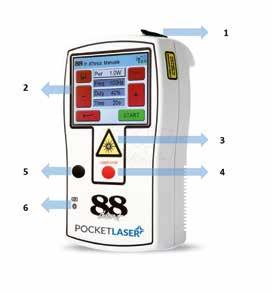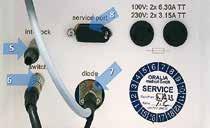
4 minute read
Main unit
by Grupo Asís
The main unit contains all the technology necessary for the production of the laser beam and to be able to interface with external accessories. It differs in shape, weight, size and build quality depending on the active medium and the intended use of the device (" 2.2 and 2.3 and ! 2.10-2.12).
The chassis/case is the enclosure of the unit. It must first protect and isolate the internal components from the external environment, effectively behaving like a shell.
Advertisement
Among the most commonly used materials for the construction of the case, there are plastic and polymeric materials that can be printed and adapted according to the specific needs of the manufacturer. They can, for example, integrate display and control housings.
Among metallic materials, aluminum is sometimes used, which acts as a Faraday cage, performing the function of isolating the internal environment from any electrostatic field present outside it.
Traditional units are static, typically removable, and require dedicated support and constant connection to the power source. Due to their size and heavy weight (sometimes over 10 kg), they are generally placed on special electrified carts.
With due caution, they can be moved short distances within the clinic.
In the case of transportable units, the overall dimensions are contained and the weight varies from 5 to 10 kg.
Technological advances nowadays allow the creation of miniaturized components, making it possible to assemble high-performance portable devices. Portable or even handheld units are able to reach a total weight of less than 1 kg.
In relation to type, model, manufacturer, the following components can be identified on the main unit by observing its chassis: Ä on/off button; Ä security key; Ä key/button/emergency lever; Ä display; Ä commands (sometimes integrated into the display); Ä power connector; Ä pedal connector; Ä connector for remote locking device; Ä service connector (for example serial/USB); Ä cooling vents; Ä optical output-connection for means of conduction. The power key allows the clinician to start the system making the device operative. It can be on the front or back of the unit. Some units additionally have an ignition/security key.
In the event of malfunction, emergency or necessity, the operator can immediately stop the activity of the diode. The key in charge is generally red and placed in a clearly visible and easily accessible position of the unit.
The display can be reduced to a simple LED panel with multiple digits or can be a real liquid crystal display, monochrome or color, with low or high resolution.
A simple control panel is usually sufficient to control the device settings. Configurations that provide touch-sensitive keys or in any case without continuity
" 2.2 445 nm blu desktop diode laser (Zoetec, Padua, Italy)
Specifications Laser class
Laser source
Weight Dimension (L×D×H) Wavelength Maximum power Pulse frequency Emission mode
Software type 4
Diode
2200 g 28 × 26 × 28 cm
445 nm
4 W, CW 0-20,000 Single, repeated, pulse train Preset, customizable and assisted
" 2.3 Portable diode laser (Pocket Laser®, 88Dent, Pero, Milan, Italy). Highlighted pocket dimensions and low weight, less than 1 kg
Specifications Laser class
Laser source 4
Diodo
Weight 0,7 kg Dimensions (L×D×H) 10.1 × 16.4 × 4.5 cm Wavelength 915 nm Maximum power 6 W, CW nominal power; 10 W max
Pulse frequency Emission mode 20 Hz - 15 KHz
Single, repeated, pulse train
Software type Preset, customizable and assisted
solutions are preferred, so as to favor the hygiene control and disinfection of the device.
Most modern units have color monitors with touch capabilities; therefore they perform the simultaneous function of display and control panel. The touchscreen can be resistive or capacitive. In this last case, touchscreen displays must be able to allow operation also through the use of gloves and through the interposition of protective films.
Depending on the presence of an internal or external power supply system, a different type of power connector is provided (! 2.12 and 2.13).
To interact with the diode, the operator communicates the instructions through the control panel and activates
! 2.10 Blue 445 nm desktop diode laser (Zoetec, Padua, Italy). The controls are integrated into the touchscreen display. The optical output connected to a MULTITIP handpiece is visible. The unit is equipped with an internal power supply.

! 2.12 915 nm portable/handheld diode laser. (1) optical connection; (2) touchscreen display; (3) status led; (4) emergency-stop button; (5) power button; (6) power/battery/charge led (Pocket Laser®, 88Dent, Pero, Milan, Italy). ! 2.11 810 nm diode laser (Ora-laser d-lux®, ORALIA, Konstanz, Germany). (1) Touchscreen display; (2) emergency button; (3) power button; (4) handpiece; (5) interlock connection; (6) remote pedal connection; (7) optical connection; (8) service serial port; (9) laser specifications; (10) integrated power cable.




! 2.13 915 nm portable diode laser. Left side portion: (7) mini-USB service port; (8) power/charging connector; (9) ventilation/cooling vent. Upper portion: (1) optical connection; (10) ventilation grille and cooling fan; (11) laser specifications (Pocket Laser®, 88Dent, Pero, Milan, Italy).






